A wine aerator is a device designed to expose wine to air, typically as it is poured from the bottle into a glass. The purpose of a wine aerator is to accelerate the aeration process, allowing the wine to "breathe" and develop its full range of flavors and aromas more quickly than traditional methods such as decanting.
Gather Your Supplies
First things first, you'll need to gather your supplies. Here's what you'll need:
• A bottle of your favorite wine
• A wine aerator of your choice
• Wine glasses for serving
• Optionally, a decanter for further aeration (especially for older wines)
Once you've got everything you need, it's time to move on to the next step.
Step 1: Uncork the Wine
Carefully remove the foil capsule from the top of the wine bottle, then use a corkscrew to extract the cork.
Be sure to twist the corkscrew all the way into the cork to avoid any potential breakage.
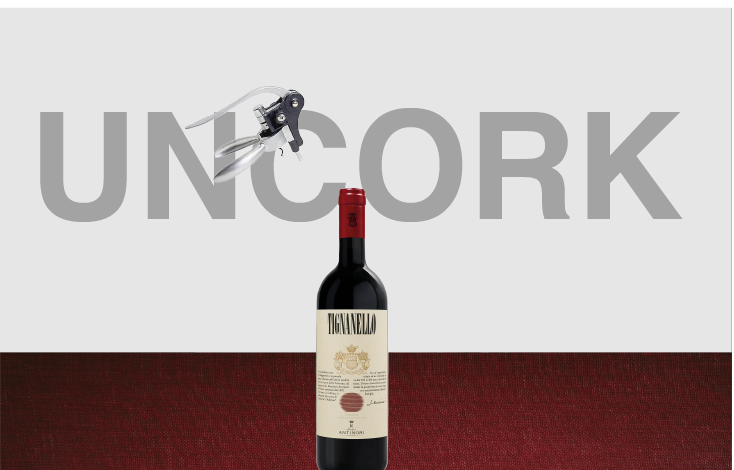
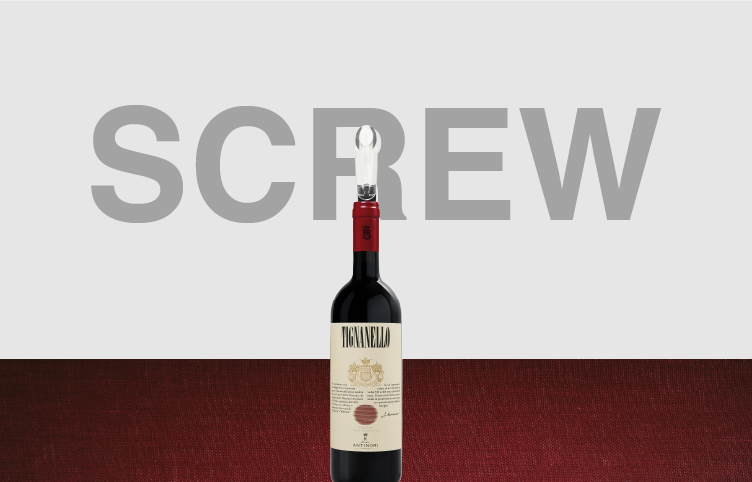
Step 2: Position the Wine Aerator
Now, it's time to position your wine aerator. If you're using a pour-through aerator or an electric Wine
Aerators, simply place it atop your wine glass, making sure it's securely in place. If you're using a
handheld aerator, hold it over the mouth of the wine glass, ready to pour.
Step 3: Serve and Enjoy
With your wine aerator in position, slowly pour the wine into the aerator. Take your time and pour in a steady, even stream to ensure proper aeration. As the wine flows through the aerator, it will mix with air, enhancing its flavors and aromas. Once you've poured the wine through the aerator, it's time to serve and enjoy! Pour the aerated wine into your wine glasses, taking note of its enhanced bouquet and smoother texture. If you're feeling fancy, you can even give the wine a gentle swirl in the glass to further aerate it before taking your first sip.
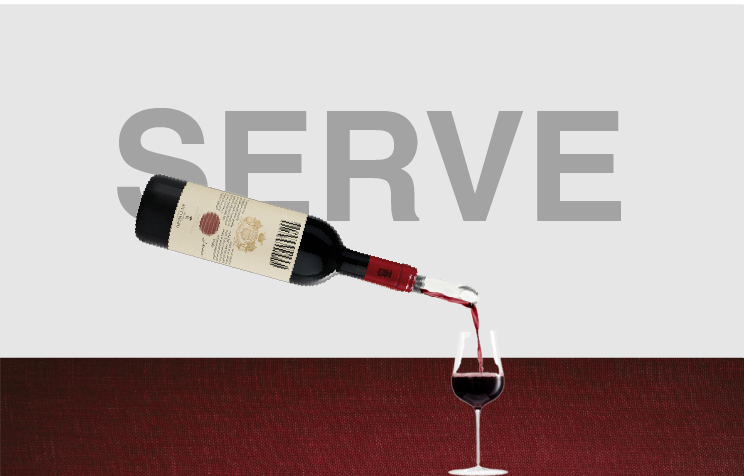
Additional Tips:
• Experiment with different pouring speeds to see how it affects the aeration process.
• Consider aerating your wine in advance by pouring it into a decanter and letting it sit for 30
minutes to an hour before serving.
• Don't forget to clean your wine aerator after each use to prevent any buildup of sediment or
residue.
First up, we have the tried-and-true decanter. A staple in any wine enthusiast’s arsenal, decanters have been used for centuries to aerate wine and separate sediment. These elegant vessels come in a variety of shapes and sizes, from sleek modern designs to ornate crystal creations. To use a decanter, simply pour your wine into the vessel and let it sit for a while, allowing it to come into contact with oxygen and mellow out. Decanters are particularly well-suited for older wines with a significant amount of sediment, as the wide base and long neck provide ample surface area for aeration.
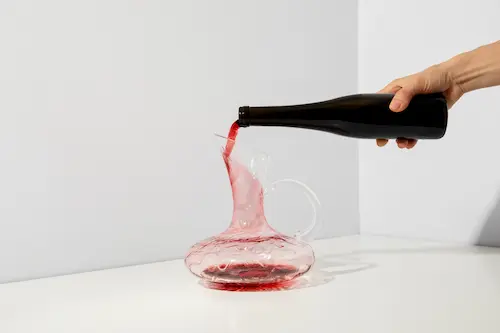
Next, we have pour-through aerators, perhaps the most popular type of wine aerator on the market today. These ingenious devices attach directly to the mouth of your wine bottle and work by rapidly mixing air with the wine as you pour. One of the key benefits of pour-through aerators is their simplicity and ease of use. With just a quick attach-and-pour motion, you can aerate your wine on the spot, making them ideal for impromptu gatherings or last-minute dinner parties.
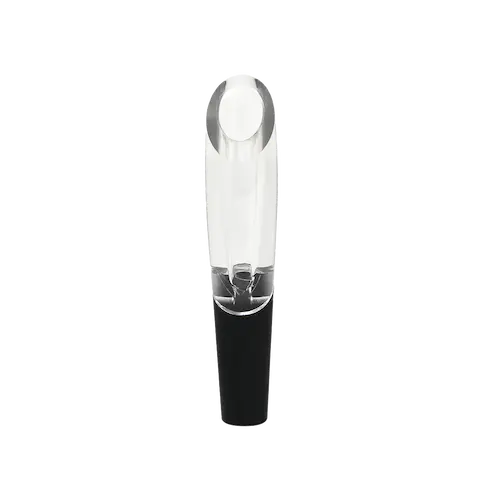
If you're looking for a more hands-on approach to wine aeration, handheld aerators might be just what you need. These compact devices typically feature a small, perforated spout that you hold over your wine glass while pouring. Handheld aerators are great for achieving a controlled pour and allowing you to tailor the aeration process to suit your preferences. Plus, their portable design makes them perfect for taking on the go, whether you're picnicking in the park or enjoying a wine tasting adventure.
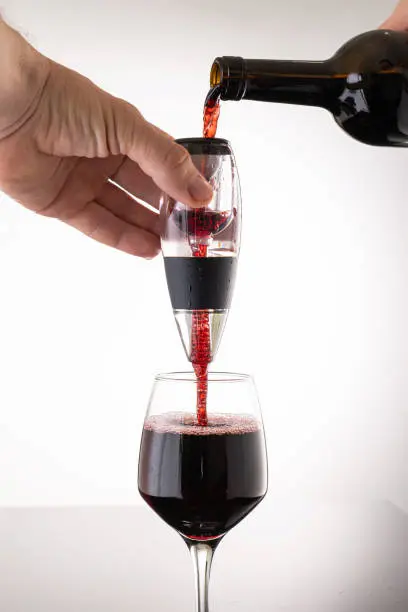
Last but not least, we have electric wine aerators—the crème de la crème of aerationtechnology. These cutting-edge devices use motorized pumps to force air into the wine, delivering instant aeration at the push of a button. Electric wine aerators are prized for their speed and efficiency, making them a favorite among busy wine enthusiasts who want to enjoy perfectly aerated wine without the wait. Some models even come with customizable settings, allowing you to adjust the level of aeration to suit your taste preferences.
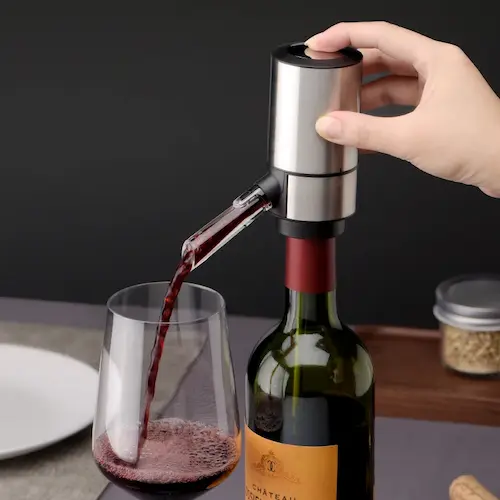
First and foremost, electric wine aerators are a godsend for bold red wines. Think rich, full-bodied varieties like Cabernet Sauvignon, Merlot, and Syrah. These wines often benefit from aeration to help soften tannins and open up their complex flavors. By using an electric wine aerator, you can achieve rapid aeration, allowing you to enjoy your favorite bold reds at their absolute best in a fraction of the time. No more waiting hours for your wine to decant—simply press a button, and voilà!
Young wines, especially those fresh off the shelf, can also benefit greatly from the aerating power of an electric wine aerator. These wines may be tight and closed upon opening, with flavors and aromas that need a little coaxing to fully express themselves. With an electric wine aerator, you can quickly infuse young wines with oxygen, helping to unlock their true potential and reveal their flavors. It's like giving your wine a jumpstart, ensuring that it's ready to be enjoyed from the very first pour.
While electric wine aerators are often associated with red wines, they can also work wonders for certain white wines, particularly those with a bit of age or structure. Chardonnay, Sauvignon Blanc, and Viognier are just a few examples of white wines that can benefit from aeration. Tight whites may exhibit subtle nuances that can be brought to the forefront with aeration, enhancing their complexity and depth. An electric wine aerator provides a quick and efficient way to achieve this, allowing you to enjoy your favorite whites in all their glory.
When it comes to classic pour-through aerators, the Vinturi Wine Aerator reigns supreme. This iconic device has been a favorite among wine lovers for years, thanks to its patented design and proven results.The Vinturi works by increasing the wine's velocity as you pour, creating a vacuum that draws in just the right amount of air to enhance its flavors. It's simple, effective, and perfect for both novice and experienced wine enthusiasts alike.
For those who prefer a more modern approach to wine aeration, the Rabbit Super Aerator is a top contender. This sleek device attaches directly to the mouth of your wine bottle and features a unique aerating system that delivers a steady stream of air with every pour. The Rabbit Super Aerator is known for its durability and ease of use, making it a favorite among busy wine lovers who want to enjoy perfectly aerated wine without any hassle.
If you're looking for a wine aerator that doubles as a conversation starter, look no further than the Soiree In-Bottle Wine Aerator. This elegant device fits snugly into the neck of your wine bottle, allowing you to aerate your wine as you pour.
For those who crave speed and convenience, the Aervana Electric Wine Aerator is the ultimate solution. This high-tech device uses motorized pumps to aerate your wine at the push of a button, delivering instant results with minimal effort. The Aervana is perfect for busy wine enthusiasts who want to enjoy perfectly aerated wine without the wait. Plus, its sleek design and compact size make it a stylish addition to any wine lover's collection.
Calling all wine professionals! If you're serious about delivering an exceptional wine experience to your customers, then investing in the right wine aerator is non-negotiable. In this section, we'll explore the features and benefits to look for in a wine aerator specifically designed for professionals like yourself.
First and foremost, professionals in the wine industry often require tools that can deliver results quickly and efficiently. When choosing a wine aerator, look for models that offer rapid aeration without compromising on quality. Time is of the essence in a busy restaurant or wine bar, so having an aerator that can deliver instant results is essential.
In a professional setting, equipment needs to withstand the rigors of daily use. Look for wine aerators made from high-quality materials such as stainless steel or BPA-free plastic, which are durable and easyto clean. Additionally, opt for models with a reputation for reliability to ensure that your aerator performs consistently day in and day out.
In the world of wine, presentation is key. Choose a wine aerator that not only performs well but also adds an element of elegance to your wine service. Sleek, modern designs or classic, timeless aesthetics can enhance the overall dining experience and leave a lasting impression on your customers.
Ultimately, the goal of any professional in the wine industry is to ensure customer satisfaction. By investing in a high-quality wine aerator, you can enhance the flavors and aromas of your wines, providing an unforgettable tasting experience for your customers.
One of the most pervasive myths about wine aeration is that all wines benefit from it. While it's true that many wines can benefit from aeration, not all wines require it. In fact, some delicate white wines and older reds may actually be harmed by excessive aeration, as it can cause them to lose their subtle nuances and aromas.
The truth is, the need for aeration varies depending on the wine's age, varietal, and structure. Young, full-bodied reds with high tannins often benefit the most from aeration, as it helps to soften their harsh edges and allow their flavors to fully develop. However, lighter-bodied wines and older vintages may require more delicate handling to preserve their delicate flavors.
Another common myth about wine aeration is that it can't improve cheap wines. While it's true that aeration won't magically transform a low-quality wine into a masterpiece, it can certainly help to enhance its flavors and aromas. Even inexpensive wines can benefit from aeration, as it helps to mellow out any harsh flavors and bring out the wine's best attributes. Think of it as giving your wine a helping hand, allowing it to shine to its fullest potential regardless of its price tag.
Wine aeration is a topic that often sparks curiosity and questions. In this section, we'll address some common queries to help deepen your understanding of this essential aspect about wine aerator.
Absolutely! Wine aerators are designed to expose wine to oxygen, which can help to soften harsh tannins, enhance aromas, and improve overall flavor. While the degree of improvement may vary depending on the wine and the aerator used, many wine lovers swear by the benefits of aeration.
While not all wines require aeration, it can certainly enhance the tasting experience for many varieties, particularly young, full-bodied reds. Aeration allows the wine to "breathe," opening up its flavors and aromas and making it more enjoyable to drink. However, lighter-bodied wines and older vintages may not benefit as much from aeration and may even be harmed by excessive exposure to oxygen.
No, aerating wine does not reduce its alcohol content. The alcohol content of wine is determined during the fermentation process and remains unchanged regardless of aeration. However, aeration can help to soften the perception of alcohol in the wine, making it taste smoother and more balanced.
While wine aeration can enhance the flavors and aromas of wine, it does not directly impact the likelihood of experiencing a hangover. Hangovers are primarily caused by dehydration and the body's response to alcohol consumption, rather than the aeration process. To minimize the risk of hangovers, it's essential to drink alcohol responsibly and stay hydrated.
The duration of aeration depends on several factors, including the wine's age, varietal, and structure. In general, younger, full-bodied red wines benefit from longer aeration periods, typically around 30 minutes to an hour. Lighter-bodied wines and older vintages may require shorter aeration times to avoid overexposure to oxygen. However, it's always a good idea to taste the wine periodically to determine when it has reached its optimal flavor profile.
Aeration can help to soften the harshness of sulfites in wine, but it does not remove them entirely. Sulfites are naturally occurring compounds that act as preservatives in wine, and while aeration can help to mellow their flavor, it does not eliminate them from the wine. If you have a sensitivity to sulfites, it's best to choose wines with lower sulfite levels or consult with a healthcare professional for personalized advice.
In general, young, full-bodied red wines benefit the most from aeration, as it helps to soften their tannins and open up their flavors. Examples include Cabernet Sauvignon, Syrah, and Malbec. However, lighter-bodied reds and some white wines can also benefit from aeration, depending on their age and structure. It's essential to experiment and taste wines to determine which ones benefit from aeration.
Both decanting and aerating wine serve the purpose of exposing it to oxygen, but they do so in slightly different ways. Decanting involves pouring the wine into a separate vessel (a decanter) to separate sediment and allow it to breathe gradually. Aeration, on the other hand, typically involves exposing the wine to air as it's poured through an aerator directly into the glass. The choice between decanting and aerating depends on personal preference and the specific characteristics of the wine. In general, decanting is ideal for older wines with sediment, while aerating is suitable for younger, full-bodied wines that benefit from rapid aeration.